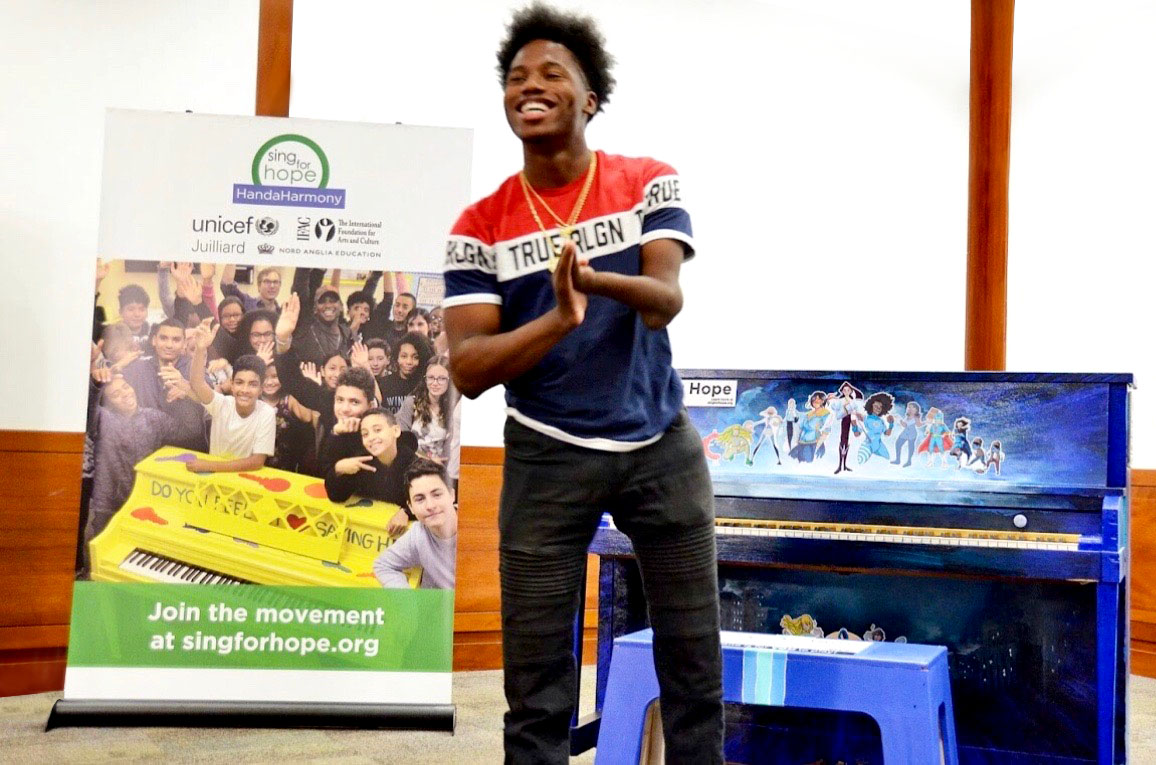Where do children and the arts belong in conversations on global social development? Front and center, say UNICEF, Sing for Hope’s HandaHarmony program, Juilliard, Nord Anglia Education, and youth participants from around the world. These leading organizations, in conjunction with UN Member States, co-hosted a side event at the High Level Political Forum (HLPF) celebrating how young people are using art and advocacy to further the UN’s Social Development Goals (SDGs). The event, titled “Child and Youth Art, Advocacy and Action to be Safe to Learn: A student presentation on SDGs 4 and 17,” brought together 100 students from around the world, showcasing how their creativity can be used to end violence in schools and compelling Member States to include youth arts in their SDG efforts.
UNICEF defends the rights of our world’s children and young people every day. Their July event, which brought together major arts institutions Juilliard, Nord Anglia Education, and Sing for Hope, recognized that the arts play a vital role in furthering this social development. The event presented the arts as a tool for our youth to be champions for themselves. “Let’s be more tolerant and strive for a world where everyone can live in peace,” says Rizka Ramli, 18, the winner of UNICEF’s School Superhero Comic Contest. Rizka’s comic features a unique superhero who possesses a magical sketchbook, which she shares with others so they can draw and bring to life whatever they need to stop the violence around them. Rizka’s designs are featured on a special Sing for Hope Piano that was unveiled at UNICEF House.
This flagship Sing for Hope Piano was created by Sing for Hope artist partners Sydney Foreman and Arelí Rocha and features artwork sourced by UNICEF from submissions by more than 3,600 children and youth worldwide, including Rizka. At the conclusion of the July 16th event, Sing for Hope placed the superhero-inspired SFH Piano at Dag Hammarskjöld Plaza, a.k.a. “The Gateway to United Nations,” where it remained open to the public through August 2nd. This fall, it will be placed in a permanent home in a local NYC public school as part of Sing for Hope’s ongoing partnership with the New York City Department of Education.
This SFH Piano is just one of 500 that Sing for Hope has brought to the public spaces of NYC in their highly anticipated annual public art project. While Sing for Hope artist partners also work directly with patients in healthcare facilities and community centers, public art is itself a catalyst for community and individual wellness. Public art’s impact is increasingly recognized as much deeper than simply the aesthetic beauty it provides, as evidenced by the growing number of hospitals investing in public art specifically for its healing power (Wall Street Journal). Sing for Hope’s take on public art draws community members into active engagement with the art and each other, because the canvases are themselves playable, interactive instruments—played alternately by children at their local park, Lin Manuel Miranda in his Washington Heights neighborhood, and Rachel Platten on her way to Madison Square Garden.
The Sing for Hope Pianos installation is a wellness intervention in the purest sense: people of all backgrounds are compelled to put down their phones (though the unique pianos do make compelling photo ops), to pull from their memories their fifth grade recital pieces, or to slowly pick out “Baby Shark” with a stranger while the toddlers of NYC look up in shock. “How did you make the piano sound like Moana?!” asked a five-year-old girl at a Sing for Hope Piano at Fosun Plaza at 28 Liberty Street. “Here, I’ll show you,” said the pianist. And the five-year-old girl and her mother received their first piano lesson.
The effect of these arts interventions on NYC, cultural capital of the world, is well established—but the July 16th event at UNICEF, featuring global organizations and youth from around the world, reiterated that this work is needed for all of the world’s people. This made it a fitting setting to announce Sing for Hope’s new global arts program HandaHarmony, made possible by the International Foundation for Arts and Culture (Dr. Haruhisa Handa, Chairman and Sing for Hope Global Patron). Founded by Dr. Haruhisa Handa in 1996, IFAC supports and funds various programs internationally that aim to champion and advance arts, culture, and education globally.
Says Dr. Haruhisa Handa, “I believe that music and the arts have the power to transform human hearts and minds, to draw us inward and upward to make the world around us a better place. Sing for Hope brings this transformational power to the disenfranchised of society.” IFAC’s International Executive Director Midori Miyazaki adds, “there has never been a more important time for us collectively, as global citizens, to bring hope and healing to those individuals and communities who are too often left behind. Sing for Hope does this each and every day.”
The energy at UNICEF House on July 16th was indeed charged with hope and inspiration. Nord Anglia students from around the world joined Sing for Hope Youth Artist Kaylin Hedges to sing “Dream Big, Speak Loud,” by Jennifer Walsey, to a room full of world leaders. “If you have a dream, hold on, you must envision your future is strong. Dream big, speak loud, let the world hear you.” If the arts are truly to bring about healthier, more vibrant and equitable communities, it will take this kind of innovative collaboration, and it will take this advocacy from our youth. The question is: are we listening?
Rizka Ramli, winner of UNICEF and Comics Uniting Nations’ School Superhero Contest
Youth participants from around the world pose with the UNICEF Sing for Hope Piano, made possible by IFAC
Student choristers from Nord Anglia schools around the world join Sing for Hope Youth Artist Kaylin Hedges in singing “Dream Big, Speak Loud,” by Jennifer Walsey
Pianist Darrius Simmons at UNICEF House


